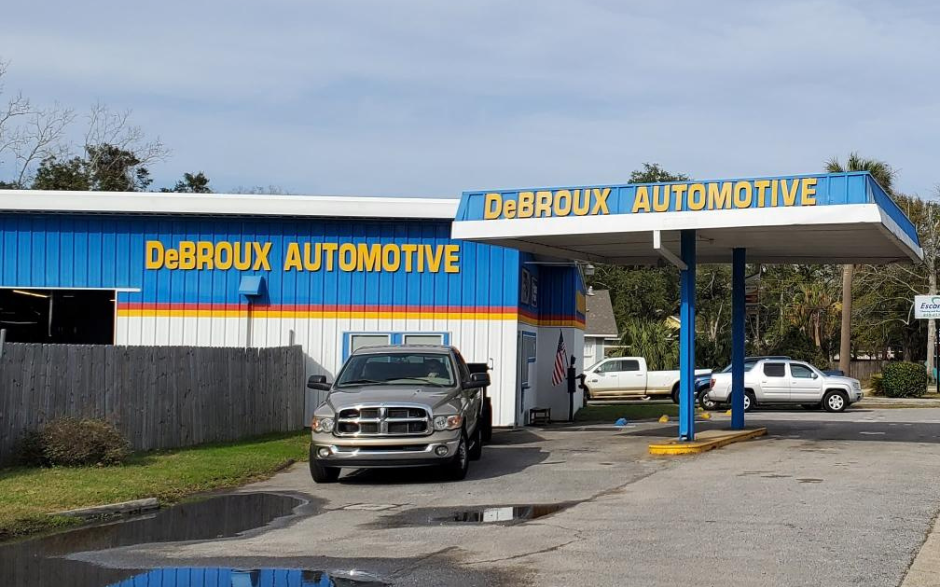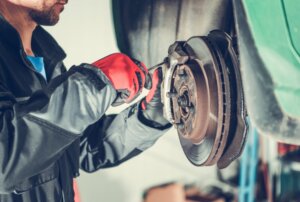Your car’s brakes are essential to your safety on the road. Brakes work hard, though, and they don’t last forever. Unfortunately, it can be tough to tell when it’s time for brake repair, new brake pads, or brake replacement.
Let your brakes go too long without service, though, and you create a safety issue that can impact you and other motorists. It’s a significant car maintenance mistake you don’t want to make.
Don’t worry, though. You can avoid that auto repair snafu by taking care of your braking system before it becomes an issue.
In this blog, we’ll discuss when to replace your brake pads and rotors and how to notice the tell-tale signs that it’s time to see a mechanic for brake repair.
How Your Brake System Works
Today’s cars have brakes on all four wheels. A hydraulic pressure system operates the brakes.
The car’s front brakes bear more weight when stopping the vehicle, so they tend to wear out faster.
While most cars have disc brakes in the front and drum brakes in the rear, some high-performance and high-end cars have all-disc braking systems.
Disc vs. Drum Brakes
While brakes are essential to all modern cars, not all brakes are created equal. Here’s a brief breakdown of the difference between disc and drum brakes:
Drum Brakes 101
Drum brakes were invented by a French manufacturer named Louis Renault in 1902. The drum brake has several components, including a housing connected to the wheel, brake shoes, and a brake pedal.
When you step down on the brake pedal in a drum brake-equipped car, the master cylinder engages the brake shoes, causing them to rub against the inside of the drum as it rotates. This creates friction that slows the wheel down.
Drum brakes are popular due to their affordability. People also like them for their increased friction contact area and long lifespan. The downside is that drum brakes can overheat in high braking conditions. They may also “grab” when wet or rusty.
Disc Brakes 101
These brakes were popularized in the 1950s when the high-end car brand Jaguar used disc brakes on a prominent racing vehicle.
Disc brakes are made up of a disc or rotor, a caliper that houses the brake pads, and a piston.
When you step on the brake pedal in a car equipped with disc brakes, it forces hydraulics to push the piston in the caliper, which applies pressure to the brake pad on one side, while the piston’s backward force pulls the brake pad on the other side of the rotor.
This, in turn, squeezes the disc and slows the vehicle to a stop.
Disc brakes are popular because engaging them requires less effort and generates greater braking force. They also dissipate heat effectively and perform well in all weather conditions, including wet roads.
The disadvantages of disc brakes are that they are expensive to produce and that the rotors warp and the pads wear out over time.
5 Signs That You Need Brake Repair or New Brake Pads

If you notice any of the following signs, it’s time to get your car to your local Pensacola mechanic:
1. Your brakes squeal even if you aren’t using them
When you press the brakes, squealing is sometimes expected. For example, if you’re applying the brakes for the first time after a cold start, they might squeak a bit.
If they squeak or squeal even when you aren’t using them, though, there’s a problem.
In most cases, the wear indicator on your brake pads (a small metal part on the brake’s backing plate) causes the squealing. The noise results from the indicator rubbing against your brake’s rotor or disc.
When you hear squealing like this, it’s a warning that you must replace your brake pads now or face a dangerous (and expensive) brake issue.
2. Your car pulls, shudders, or shakes when you apply the brakes
If your vehicle pulls hard to the left or right, shudders, or shakes through the steering wheel when you step on the brakes, it’s a sign that you need brake repair ASAP!
These are all signs that one side of your car’s brakes works optimally while the other side is compromised or needs repair.
3. Your brakes make a grinding or growling noise

Noises, in general, are a bad sign for brakes. If your brakes make a low, metallic grinding or growling noise when you apply the brakes, it’s a significant danger sign.
This usually means that your brake pads are worn. It may also indicate that your brakes’ backing plates are coming into contact with the metal discs or drums.
This metal-on-metal contact is incredibly damaging for your car and can quickly spread out to other vehicle systems.
4. Your brake indicator lights are on
One of the first signs that it’s time for brake repair is that your vehicle’s indicator lights come on.
Some lights indicate that your brake pads are starting to wear thin, while others are more general warning sensors related to your anti-lock braking system.
If you notice any of these lights on your dashboard, get your car to your local auto mechanic as quickly as possible.
5. You have less than a quarter inch of brake pad left
If your car has disc brakes, you can inspect your brake pads to determine if it’s time for brake repair.
Simply look down into the brake assembly that holds the brake pads and check the material on the brake pad or shoe.
If it’s less than ¼” thick, it’s time to have your brakes inspected and replaced, as needed.
DeBroux Automotive: Your Source for Reliable Brake Repair

Don’t delay your auto repair and let your car become an accident waiting to happen.
You can’t trust your vehicle to just anyone when you need brake repair.
Here at DeBroux Automotive, we specialize in offering reliable, high-quality brake service and repair for customers in and around the Pensacola area.
Whether you need new rotors or brake pads or a full inspection by a qualified mechanic, we are here for you. Contact us today to learn more and schedule your appointment.
